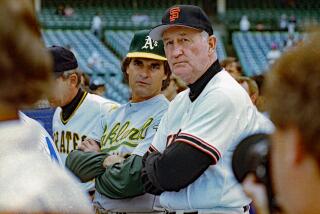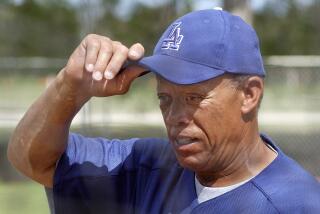Clark Developed ‘Natural’ Swing Through Hard Work
- Share via
SCOTTSDALE, Ariz. — To Al Rosen, the sound was unmistakable. On an adjacent diamond, a baseball player was taking swings in a batting cage and lashing line drives in all directions. The crack of the bat reverberated throughout the San Francisco Giants’ training complex at a public park here.
“Listen to that,” said the general manager, seated in a golf cart nearby. “You don’t have to see him to know who’s hitting.” Will Clark, the natural, was going about his business.
It’s a business at which he excels. Clark begins his fourth full professional season as the National League’s reigning runs batted in champion and All-Star first baseman. But to those who follow baseball closely, his achievements are almost secondary to the smooth stroke that has propelled him to the forefront of his profession at the age of 25.
“Everybody talks about the natural swing,” he said, not without a measure of pride.
That he has made it look easy may be his greatest burden. After all, this is a man who homered in his first two professional at-bats for Fresno of the California League, who homered off Nolan Ryan at the Astrodome in his initial appearance in the majors and who homered again in his first game as a Giant at Candlestick Park.
But Clark takes nothing for granted, least of all hitting a baseball.
He goes back to work each winter, refining his talent under the tutelege of Barry Butera, a former outfielder in the Boston Red Sox organization whose career was stunted by knee problems and the presence of such stars as Carl Yastrzemski, Fred Lynn, Jim Rice and Dwight Evans.
A disciple of Ted Williams, Butera was staging hitting clinics in New Orleans when Clark encountered him in the summer between his junior and senior years of high school.
“I was pretty much a dead pull hitter,” he recalled. “But he told me you have to hit the ball all over in the majors. He taught me to hit it where it’s pitched on the plate. And not just flick it, either, but drive it.”
By the time Clark was selected by the Giants in the first round of the June 1985 free-agent draft, following an outstanding career at Mississippi State and a rigorous tour with the 1984 U.S. Olympic team, he was a polished hitter with power to all fields.
Rosen still was employed by the Astros when he first saw Clark, then an Olympian, swing a bat. “I told someone, ‘How lucky do you have to be to have a guy like that on your team?’ ” the executive recalled. “Then I got here and found out.”
Indeed, Rosen made Clark a cornerstone of the rebuiling program that produced a division championship in 1987. The first baseman has been so consistent that he has been elevated into the company of Don Mattingly, at least in trade talks. When George Steinbrenner fumed over Mattingly’s outspoken criticism amid the ruins of the 1988 season, he entertained offers from several clubs this past winter, among them the Giants.
“That was my first brush with trade rumors,” Clark said, exhibiting a crooked grin that announced he was more flattered than miffed. “Al came to me (this spring) and said, ‘I’m not going to kid you. We did talk.’ But I told him, ‘That’s your job. My job is to hit.’ ”
Case closed, at least for now. Certainly, the thought of playing 81 games in Yankee Stadium didn’t trouble the left-handed batter. Candlestick remains a hostile environment for anyone who makes his living swinging a bat, and this is a man who is just developing into the hitter he thinks he can be.
“I’ve grown up a lot at the plate,” Clark said. “I’m starting to get prepared a lot more in the on-deck circle and let it happen at the plate. In my rookie season, I did a lot of thinking at the plate. When I finally got the pitch I wanted, I missed it. I was thinking too much.”
It was Yogi Berra who once observed that you can’t think and hit at the same time. As so often happened, the underlying wisdom was obscured by the humor of the phrasing. But it’s something that all good hitters learn, the sooner the better.
Clark already has endured the longest period of adversity of his professional career, a .230 start that stretched into June last season. But he rebounded to finish among the league leaders in extra-base hits and runs scored as well as drive in 109 runs despite a diminished Giants offense.
He studied videotapes of himself over the winter in the company of Butera and seems ready to emerge as one of the premier players in the game. Whether the general public will take note is something beyond his control.
In his first prolonged appearance in the national spotlight, the 1987 National League championship series, the media was more attuned to the Clark who didn’t play for St. Louis because of an injury than the Clark who did play for San Francisco.
Now Jack Clark is back in the National League and will play first base for the San Diego Padres, a contender in Will Clark’s division. Eddie Murray also has surfaced in Los Angeles after a lifetime in Baltimore. “A few years ago,” the younger Clark decided, “people only talked about Keith Hernandez. Now we’ve got a ton of gifted first basemen (in the league).”
Don’t expect the Giants’ representative to defer to any of them. He is self-assured, almost cocky in his ability, although he was upset last year when Tim McCarver advised listeners that he had adopted the nickname Will the Thrill on his own. “I told him,” Clark recalled, “‘I may be arrogant but I did not give myself a nickname.”’
That, like the swing, was a gift he has labored to deserve.
More to Read
Go beyond the scoreboard
Get the latest on L.A.'s teams in the daily Sports Report newsletter.
You may occasionally receive promotional content from the Los Angeles Times.










